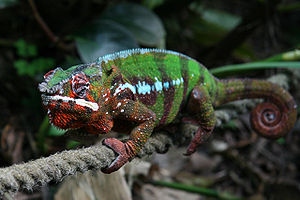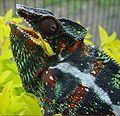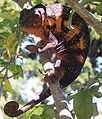- Panther chameleon
-
Panther Chameleon 
A panther chameleon at the Zurich Zoo Scientific classification Kingdom: Animalia Phylum: Chordata Class: Reptilia Order: Squamata Family: Chamaeleonidae Genus: Furcifer Species: F. pardalis Binomial name Furcifer pardalis
(Cuvier, 1829)The Panther Chameleon (Furcifer pardalis) is a species of chameleon. It lives in the eastern and northern parts of Madagascar[1] in a tropical forest biome. Additionally, it has been introduced to Réunion and Mauritius.
Contents
Taxonomy
The Panther chameleon was first described by French Naturalist Georges Cuvier in 1829.[1] Its generic name (Furcifer) is derived from the Latin root furci meaning "forked" and refers to the shape of the animal's feet.[2] The specific name pardalis refers to the animals markings as it is Latin for "leopard" or "spotted like a panther". [3] The English word chameleon (also chamaeleon) derives from Latin chamaeleō, a borrowing of the Ancient Greek χαμαιλέων (khamailéōn), a compound of χαμαί (khamaí) "on the ground" and λέων (léōn) "lion". The Greek word is a calque translating the Akkadian nēš qaqqari, "ground lion".[4] This lends to the common English name of "Panther chameleon".
Description
Male Panther Chameleons can grow up to 20 inches (50 cm) in length, with a typical length of around 17 inches (45 cm). Females are smaller, at about half the size. In a form of sexual dimorphism male Panther Chameleons are more vibrantly colored than the females. Coloration varies with location, and the different color patterns of Panther Chameleons are commonly referred to as 'locales', which are named after the geographical location in which they are found. Panther Chameleons from the areas of Nosy Be, Ankify and Ambanja are typically a vibrant blue, while those from Antsiranana and Sambava are red, green or orange. The areas of Maroantsetra and Tamatave yield primarily red specimens. There are numerous other color phases, and patterns differ between and within regions. Female Panther Chameleons generally remain tan and brown with hints of pink peach or bright orange, no matter what region they are from, but there are slight differences in patterns and colors among the different color phases.[5]
Biology
Panther chameleons are didactyl: on each foot the five toes are fused into a group of two and a group of three, giving the foot a tongs-like appearance. These specialized feet allow the Panther chameleon a tight grip on narrow branches. Each toe is equipped with a sharp claw to gain traction on surfaces such as bark when climbing. The claws make it easy to see how many toes are fused into each part of the foot — two toes on the outside of each front foot and three on the inside.
Their eyes are the most distinctive among the reptiles and function like a gun turret. The upper and lower eyelids are joined, with only a pinhole large enough for the pupil to see through. They can rotate and focus separately to observe two different objects simultaneously, this lets their eyes move independently from each other. It in effect gives them a full 360-degree arc of vision around their body. When prey is located, both eyes can be focused in the same direction, giving sharp stereoscopic vision and depth perception. They have keen eyesight for reptiles, letting them see small insects from a long (5–10 m) distance.
The Panther chameleon lacks a vomeronasal organ. Like snakes, they do not have an outer or a middle ear.
Panther chameleons have very long tongues (sometimes longer than their own body length) which they are capable of rapidly extending out of the mouth. The tongue extends at around 26 body lengths per second. The tongue hits the prey in about 30 thousandths of a second. The tongue of the chameleon is a complex arrangement of bone, muscle and sinew. At the base of the tongue there is a bone and this is shot forward giving the tongue the initial momentum it needs to reach the prey quickly. At the tip of this elastic tongue there is a muscular, club-like structure covered in thick mucus that forms a suction cup.[6] Once the tip sticks to a prey item, it is drawn quickly back into the mouth, where the Panther chameleon's strong jaws crush it and it is consumed. Ultraviolet light is part of the visible spectrum for chameleons.
Behaviour and ecology
It is a common misconception that chameleons of any kind can change colour to match any colour they are up against. All chameleons have a natural colour range with which they are born and is dictated by their species. Colour change is, for the most part, subconscious. It is affected by temperature, mood, and light. If, for example, the colour purple is not within the range of colours their particular species can change, then they will never turn purple.[1]
Like most species of chameleons, the Panther Chameleon is very territorial. They spend the majority of their life in isolation, apart from mating sessions. When two males come into contact, they will change color and inflate their bodies, attempting to assert their dominance. Often these battles end at this stage, with the loser retreating, turning drab and dark colors. Occasionally, the displays result in physical combat if neither contender backs down.[1]
Reproduction
Panther Chameleons reach sexual maturity at a minimum age of 7 months.[1]
When gravid, or carrying eggs, females turn dark brown or black with orange striping to signify to males they have no intention of mating. The exact coloration and pattern of gravid females varies depending on the color phase of the chameleon. This provides a way to distinguish between locales.[1]
Females usually only live 2–3 years after laying eggs (between 5 and 8 clutches) because of the stress put on their bodies. Females can lay between 10 and 40 eggs per clutch, depending on the food and nutrient consumption during the period of development. Eggs typically hatch in 240 days.[7]
Images
Notes
- ^ a b c d e f Andreone, F.; Guarino ,F.M. and Randrianirina, J.E.. "Life history traits, age profile, and conservation of the panther chameleon, Furcifer pardalis (Cuvier 1829), at Nosy Be, NW Madagascar". Tropical Zoology 18: 209–225.
- ^ Le Berre, François; Richard D. Bartlett (2009). The Chameleon Handbook. Barron's Educational Series. p. 4. ISBN 9780764141423.
- ^ Padilla, Michael J.; Ioannis Miaoulis (2002). From bacteria to plants. Prentice Hall. p. 30. ISBN 9780130540591.
- ^ Dictionary.com entry for "chameleon"
- ^ Ferguson, Gary; James B. Murphy, Jean-Baptiste Ramanamanjato, Achille P. Raselimanana (2004). The Panther chameleon: color variation, natural history, conservation, and captive management. Krieger Publishing Company. pp. 54, 62–63. ISBN 9781575241944.
- ^ Piper, Ross (2007). Extraordinary Animals: An Encyclopedia of Curious and Unusual Animals. Greenwood Press.
- ^ Badger, David; John Netherton (2006). Lizards: A Natural History of Some Uncommon Creatures--Extraordinary Chameleons, Iguanas, Geckos, and More. Voyageur Press. p. 71. ISBN 9780760325797.
External links
Categories:- Furcifer
- Endemic fauna of Madagascar
- Reptiles of Madagascar
- Pet lizards
- Animals described in 1829
Wikimedia Foundation. 2010.




